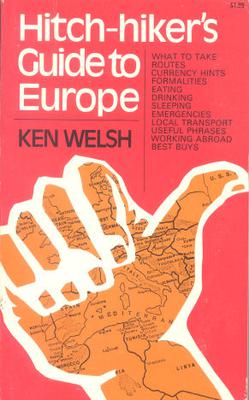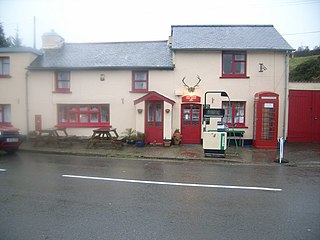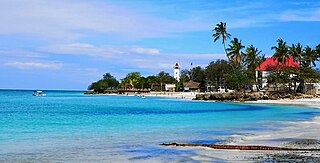Paved and unpaved roadways, as well as railways, provide the main forms of transport in Madagascar. Madagascar has approximately 31,640 km (19,660 mi) of paved roads and 836 km of rail lines. In 2010, Madagascar had 432 km (270 mi) of navigable waterways.

The Madagascar Armed Forces is the national military of Madagascar. The IISS detailed the armed forces in 2012 as including an Army of 12,500+, a Navy of 500, and a 500-strong Air Force.

Chalfont St Peter is a large village and civil parish in southeastern Buckinghamshire, England. It is in a group of villages called The Chalfonts which also includes Chalfont St Giles and Little Chalfont. The villages lie between High Wycombe and Rickmansworth. Chalfont St Peter is one of the largest villages, with nearly 13,000 residents. The urban population for Chalfont St Peter and Gerrards Cross is 19,622, the two villages being considered a single area by the Office for National Statistics.

The Hitch-hiker's Guide to Europe (ISBN 0-8128-1446-0) was a travel guide, by "Australian expatriate" Ken Welsh, and first published in 1971 in the UK by Pan Books. A first American edition was published in 1972 by Stein and Day, New York, NY, US. The book has been described as "providing valuable guidance for either the first-timer or the repeater" in Europe, the Eastern Bloc nations, Turkey, North Africa, and the Middle East and a "guide and compendium of advice for seeing Europe by the skin of your teeth".

The Malagasy or striped civet, also known as the fanaloka or jabady, is an euplerid endemic to Madagascar. It is the only species in genus Fossa.

The Limba people are an ethnic group in Sierra Leone. They represent 12.4% of the total population, making them the third largest ethnic group in Sierra Leone. The Limba are based in the north of the country across seven provinces, but are predominantly found in the Northern Province of Sierra Leone.

The River Greta is a river flowing through Lancashire and North Yorkshire in the north of England.

Betsiboka River is a 525-kilometre (326 mi) long river in central-north Madagascar. It flows northwestward and empties to Bombetoka Bay, forming a large delta. It originates to the east of Antananarivo. The river is surrounded in mangroves. The river is distinctive for its red-coloured water, which is caused by river sediments. The river carries an enormous amount of reddish-orange silt to the sea. Much of this silt is deposited at the mouth of the river or in the bay.

Countess Weir is a district within the city of Exeter, Devon, England. It lies about two miles south-east of the city centre, on the north bank of the estuary of the River Exe. Historically an estate known as Weare, part of the manor of Topsham, was in this area. From the late 13th century, the construction of weirs in the River Exe by the Countess, and later, the Earls of Devon damaged the prosperity of Exeter to the benefit of Topsham which was downstream of the obstructions, and was owned by the Earls.

Salanoia is a genus of euplerid carnivoran with two currently described species found in Madagascar. They are mongoose-like, which is reflected in the older versions of their English names, for example brown-tailed mongoose which is now called brown-tailed vontsira. The name Salanoia is derived from salano, one of the vernacular names for Salanoia concolor.

Saint Augustin is a rural municipality in Madagascar. It belongs to the district of Toliara II, which is a part of Atsimo-Andrefana Region. The population of the commune was estimated to be approximately 15,000 in 2001 commune census. The mouth of the Onilahy River is near the town.

Challacombe is a small village on the edge of the Exmoor National Park, in Devon, England. The village has a small general shop/Post Office and a single pub, the Black Venus. The village is on the B3358 road and is 5 miles west of Simonsbath.

Bradt Travel Guides is a publisher of travel guides founded in 1974 by Hilary Bradt and her husband George, who co-wrote the first Bradt Guide on a river barge on a tributary of the Amazon.

The Quilters' Guild Museum Collection, which opened in St Anthony's Hall, York on 7 June 2008 but closed on 31 October 2015, was Britain's first museum dedicated to the history of British quilt making and textile arts. The museum was founded and operated by The Quilters' Guild of the British Isles. The Guild was formed in 1979 and is the national organisation representing quilt makers throughout the country. Traditional and contemporary work is of equal importance within the Guild, and membership is open to anyone who works in patchwork, appliqué, and quilting, or has an interest in quilts.

Nungwi, or Ras Nungwi, is a large village located in the far northern end of the island of Zanzibar. With a population of 30,762, Nungwi is the second largest settlement on the island. It is situated in the Nungwi Ward in the Kaskazini A District of the Unguja North Region. It is about 35 miles (56 km) north of Zanzibar Town on the Nungwi Peninsula, about an hour drive from Stone Town. To the south Nungwi shares a border with the neighboring Matemwe- and Tazari villages. Nungwi was traditionally a fishing village and dhow-building center, but is now a popular tourist destination, and for instance recognized in CNN’s list of "100 best beaches of the world" in 2014. West Nungwi has changed a lot since the 1990s and is now a popular tourist destination with numerous resorts, restaurants, bars, stores, etc. East Nungwi is quieter and generally more laid-back.

Jane Wilson-Howarth BSc (hons), CF, MSc (Oxon), BM, DCH, DCCH, DFSRH, FRSTM&H, FFTM RCPS (Glasg) is a British physician, lecturer and author. She has written three travel health guides, two travel narratives, a novel and a series of wildlife adventures for children. She has also contributed to anthologies of travellers tales, has written innumerable health articles for non-specialist readers, and many scientific/academic papers.
In Malagasy culture, fady are a wide range of cultural prohibitions or taboos. People, places, actions or objects may be the subject of fady, which vary by region within Madagascar. The taboos are believed to be enforced by supernatural powers, and are particularly connected with Malagasy ancestor worship. Although some are held nationwide, others may be particular to regions, villages or even individual families. Fady are an integral part of Malagasy identity and play an important part in community and identity formation. The word is a descendant of Proto-Austronesian *paliSi.

Madagascar Exotic is a small privately run reserve at Marozevo, on National Road N2, 75 km (47 mi) east of Antananarivo, between the towns of Manjakandriana and Moramanga. It is a popular tourist stop between Antananarivo and Madagascar's Andasibe-Mantadia National Park.
Time in Madagascar is given by a single time zone, officially denoted as East Africa Time. Madagascar does not observe daylight saving time.

The Clock Tower in Pristina, Kosovo, was built in the 19th century by Jashar Pasha, after whom the Mosque is named not far from the Clock Tower. It served as a means of informing the town during the Ottoman Empire rule, in order to let people know when to pray as well as the traders closing their shops. The 26-meter high hexagonal clock tower was made of sandstone and bricks. The original tower was burned in fire and its bricks were used for reconstruction. The authentic bell was brought from Moldavia and has an inscription mentioning this fact. However, the circumstances of how the bell was brought to Pristina are not clearly known; its theft in 2001 is even more unclear. The same year, French KFOR troops assisted in installing a new clock by changing the old clock mechanism with an electric one.

















